Development of an automatic methodology for breast cancer detection in mammography
 The main goal of the research is developing an automatic methodology for early breast cancer detection in mammography, using image processment techniques and neural networks.
The main goal of the research is developing an automatic methodology for early breast cancer detection in mammography, using image processment techniques and neural networks.
Student: Pedro Moisés de Sousa
Advisor: Ana C Patrocinio
Decoding of neural activity for non-invasive Brain-Machine Interfaces
 Brain-Machine Interfaces (BMIs) transcribe cortical signals indo commands for assistive devices such as a prostheses, robotic arm, exoskeleton or a computer. Research on BMIs are mainly focused on the rehabilitation of people with motor dysfunctions. Most of the BMIs are based on invasive recordings of neural activity by means of Electrocorticography (ECoG) or Local-Field Potentials (LFP). Invasive BMIs are still not widely used since the surgical procedure might be risky and they are quite expensive. Therefore, this project aims at developing a non-invasive BMI based on electroencephalogram (EEG), decoding and classifying neural activity according to movement features such as trajetory and velocity.
Brain-Machine Interfaces (BMIs) transcribe cortical signals indo commands for assistive devices such as a prostheses, robotic arm, exoskeleton or a computer. Research on BMIs are mainly focused on the rehabilitation of people with motor dysfunctions. Most of the BMIs are based on invasive recordings of neural activity by means of Electrocorticography (ECoG) or Local-Field Potentials (LFP). Invasive BMIs are still not widely used since the surgical procedure might be risky and they are quite expensive. Therefore, this project aims at developing a non-invasive BMI based on electroencephalogram (EEG), decoding and classifying neural activity according to movement features such as trajetory and velocity.
Student: Amanda Medeiros de Freitas
Advisor: Alcimar B Soares
Cortical oscillations related to sensorimotor integration
 Brain-Machine Interfaces (BMIs) are of particular interest in the field of neuroengineering. Decoding motor intentions and movement features such as direction or velocity are the common goals of BMIs aimed at restoring motor functions that have been lost due to injuries or failures of the central nervous system (CNS). However, decoding such features alone might not be sufficient for achieving optimal control of robotic devices or exoskeletons using BMIs, for instance. In this scenario, it is necessary to close the loop by feeding sensory signals back into the nervous system, relying in the high adaptive capacity of the CNS to integrate these sensory signals in order to create a model of these external devices to improve their control. Therefore, I am interested into investigating sensorimotor integration in the human cortex by exploring cortical oscillations and their relationship to motor behavior. For this purpose it is possible to design experiments using EEG and EMG signals and comptutational models. Finally, basic principles of sensorimotor integration can be used to support future developments of sensorimotor BMIs.
Brain-Machine Interfaces (BMIs) are of particular interest in the field of neuroengineering. Decoding motor intentions and movement features such as direction or velocity are the common goals of BMIs aimed at restoring motor functions that have been lost due to injuries or failures of the central nervous system (CNS). However, decoding such features alone might not be sufficient for achieving optimal control of robotic devices or exoskeletons using BMIs, for instance. In this scenario, it is necessary to close the loop by feeding sensory signals back into the nervous system, relying in the high adaptive capacity of the CNS to integrate these sensory signals in order to create a model of these external devices to improve their control. Therefore, I am interested into investigating sensorimotor integration in the human cortex by exploring cortical oscillations and their relationship to motor behavior. For this purpose it is possible to design experiments using EEG and EMG signals and comptutational models. Finally, basic principles of sensorimotor integration can be used to support future developments of sensorimotor BMIs.
Candidate: Andrei Nakagawa Silva
Advisor: Alcimar B Soares
Comparison of masticatory activity in healthy individuals and individuals with temporomandibular disorders.
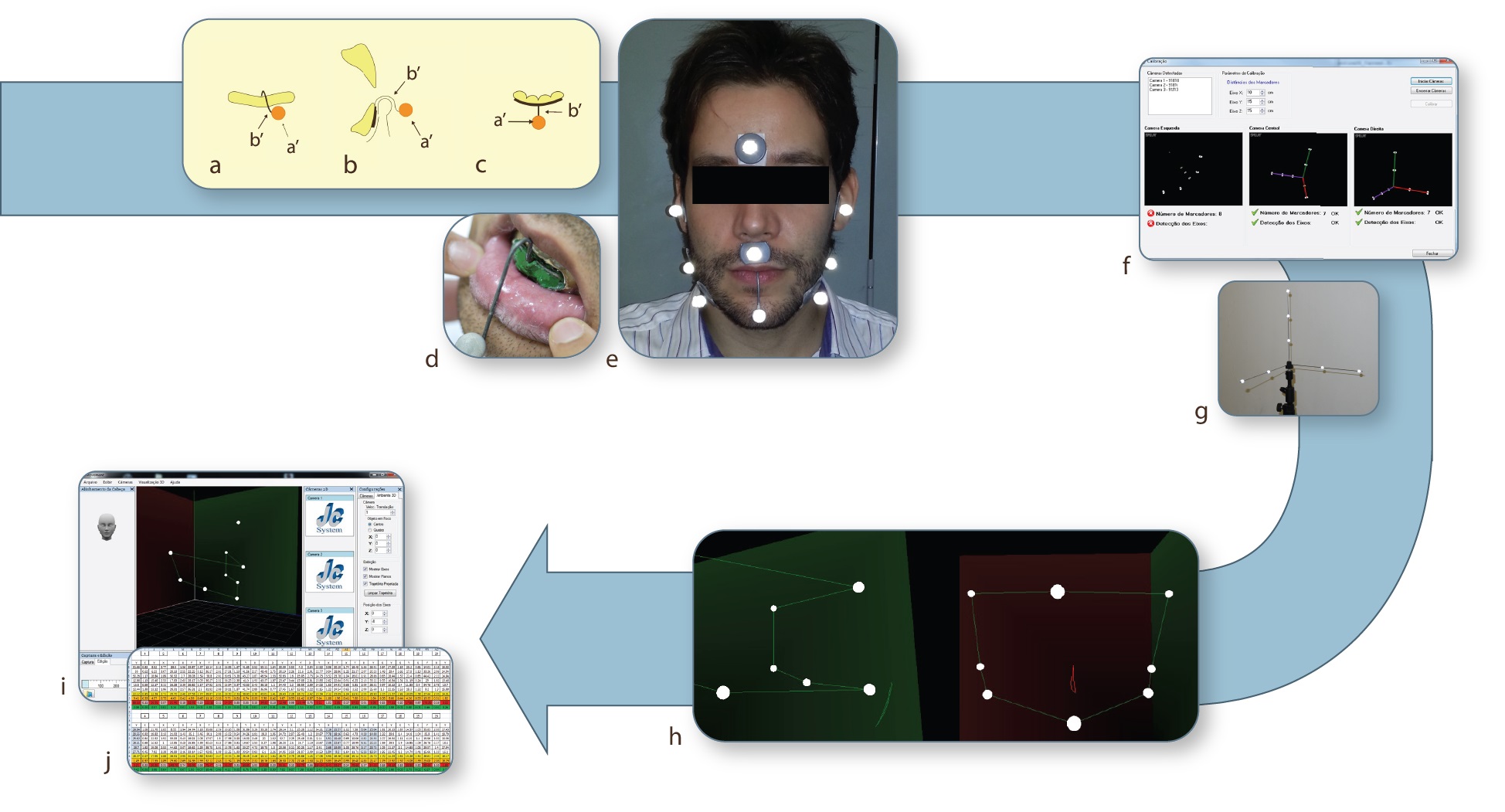 Individuals with temporomandibular diorders often show limitations in their masticatory function. Studies of this dysfunction report a prevalence of unilateral mastication, as well as deviations in mandibular movements. This research has the goal to compare masticatory patterns of healthy individuals and invididuals with temporomandibular disorders. The experiments will employ EMG signals and optoelectronic sensors (Jawcapture) developed in BioLab to characterize the masticatory activity.
Individuals with temporomandibular diorders often show limitations in their masticatory function. Studies of this dysfunction report a prevalence of unilateral mastication, as well as deviations in mandibular movements. This research has the goal to compare masticatory patterns of healthy individuals and invididuals with temporomandibular disorders. The experiments will employ EMG signals and optoelectronic sensors (Jawcapture) developed in BioLab to characterize the masticatory activity.
Candidate: Danilo Vieira da Cunha
Advisor: Adriano A Pereira
Characterizing wrist tremor in Parkinson's Disease with inertial sensors and electromyography
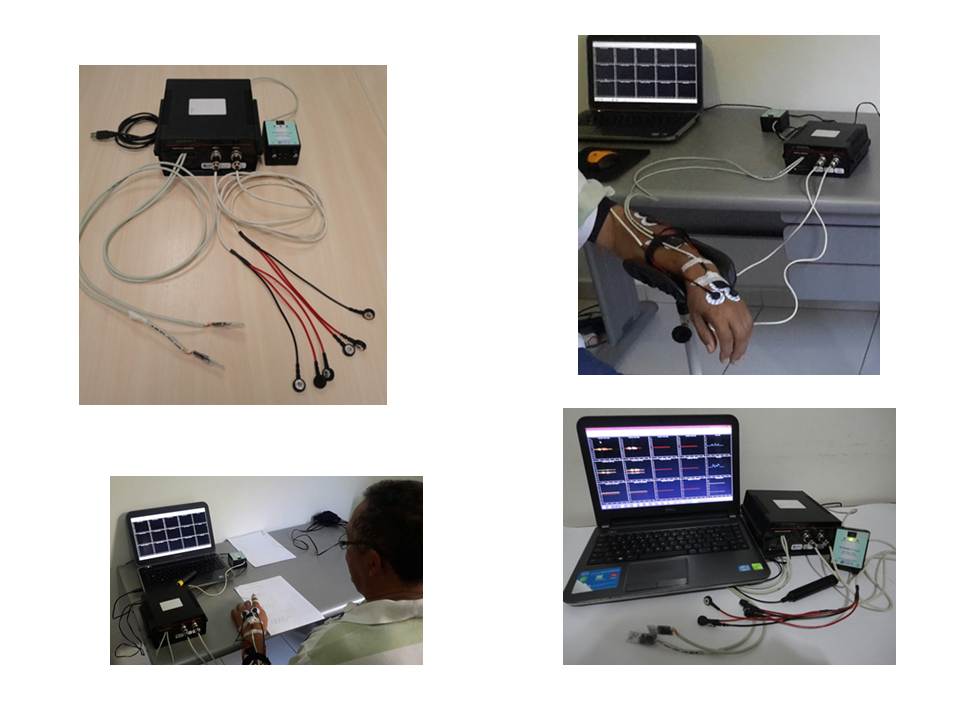
Candidate: Ana Paula de Sousa Paixão
Advisor: Adriano O Andrade
Study of human tremor in kidney transplant recipients and its relationship with neurotoxicity and immunosupression
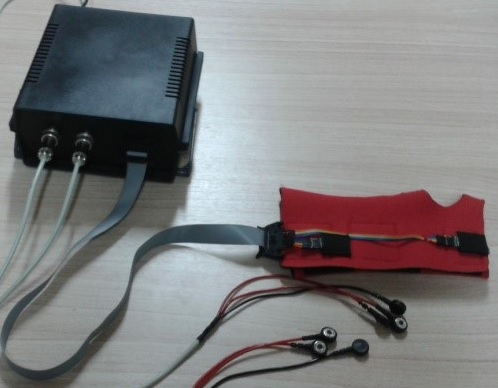 This research is divided into three steps: (i) identifying the differences of involuntary movements and wrist tremor with biomedical signal processing methods; (ii) develop experimental protocols to elucidate tremor in these patients; (iii) data analysis. Individuals will be divided into groups according to time since transplant and medication dosage and the experiment will make use of an instrumented glove to measure wrist tremor and movements.
This research is divided into three steps: (i) identifying the differences of involuntary movements and wrist tremor with biomedical signal processing methods; (ii) develop experimental protocols to elucidate tremor in these patients; (iii) data analysis. Individuals will be divided into groups according to time since transplant and medication dosage and the experiment will make use of an instrumented glove to measure wrist tremor and movements.
Candidate: Bruno Coelho Calil
Advisor: Adriano A Pereira
Decoding neural activity from EEG related to the movement of upper-limbs in 3D
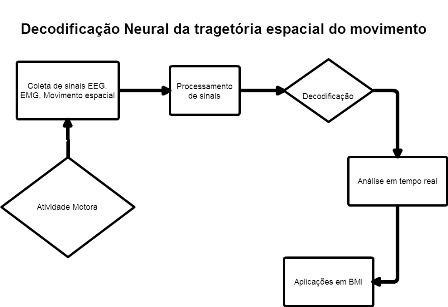 Applications of Brain-Machine Interfaces are one of the most studied topics within Neurogineering. The goal of this research is to develop real-time methods for decoding features of arm movements from EEG signals.
Applications of Brain-Machine Interfaces are one of the most studied topics within Neurogineering. The goal of this research is to develop real-time methods for decoding features of arm movements from EEG signals.
Candidate: Dhainner Rocha Macedo
Advisor: Alcimar B Soares
Parkinson's disease motor signs quantification using non-contact capacitive sensors
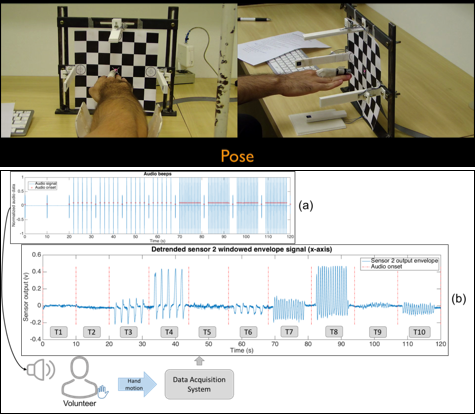 The diagnosis and evaluation of the severity of Parkinson's disease (PD) is a task that has been performed through clinical evaluation and use of subjective scales. Over the years several studies have reported results and technologies with the purpose of making the characterization of PD more objective. In this perspective, we have identified the possibility of using non-contact capacitive sensors to record the motor activity of the hand and wrist. Another identified challenge is related to the quantification of the severity of PD motor signals. In this study, we propose the use of an innovative tool, t-Distributed Stochastic Neighbor Embedding (t-SNE), for the reduction and visualization of information. It is expected that the use of this tool allows the visualization of data in a two-dimensional space and an improvement of the performance of classifiers responsible for estimating the severity of the disease. In order to evaluate the use of capacitive sensors and signal processing tools, data from groups of neurologically healthy individuals and PD will be collected. At the end of the project we hope to obtain the following contributions: (i) development and evaluation of a technology for recording motor signals of hand and wrist activities, based on capacitive contactless sensors; (ii) comparative evaluation among several tools for signal processing, in order to characterize PD.
The diagnosis and evaluation of the severity of Parkinson's disease (PD) is a task that has been performed through clinical evaluation and use of subjective scales. Over the years several studies have reported results and technologies with the purpose of making the characterization of PD more objective. In this perspective, we have identified the possibility of using non-contact capacitive sensors to record the motor activity of the hand and wrist. Another identified challenge is related to the quantification of the severity of PD motor signals. In this study, we propose the use of an innovative tool, t-Distributed Stochastic Neighbor Embedding (t-SNE), for the reduction and visualization of information. It is expected that the use of this tool allows the visualization of data in a two-dimensional space and an improvement of the performance of classifiers responsible for estimating the severity of the disease. In order to evaluate the use of capacitive sensors and signal processing tools, data from groups of neurologically healthy individuals and PD will be collected. At the end of the project we hope to obtain the following contributions: (i) development and evaluation of a technology for recording motor signals of hand and wrist activities, based on capacitive contactless sensors; (ii) comparative evaluation among several tools for signal processing, in order to characterize PD.
Candidate: Fábio Henrique M Oliveira
Advisor: Adriano O Andrade
Filtering EEG signals contaminated with EMG signals from facial muscles.
 The goal of this research is to develop computational methods for filtering EEG signals contaminated with electromyogram originated from facial muscles. Besides, we also want to characterize the contamination of EEG signals from involuntary microstimulated contractions.
The goal of this research is to develop computational methods for filtering EEG signals contaminated with electromyogram originated from facial muscles. Besides, we also want to characterize the contamination of EEG signals from involuntary microstimulated contractions.
Candidate: Gustavo Moreira da Silva
Advisor: Adriano O Andrade
Muscular strengthening exercises and electromyographic biofeedback applied to upper-limb rehabilitation of post-stroke subjects
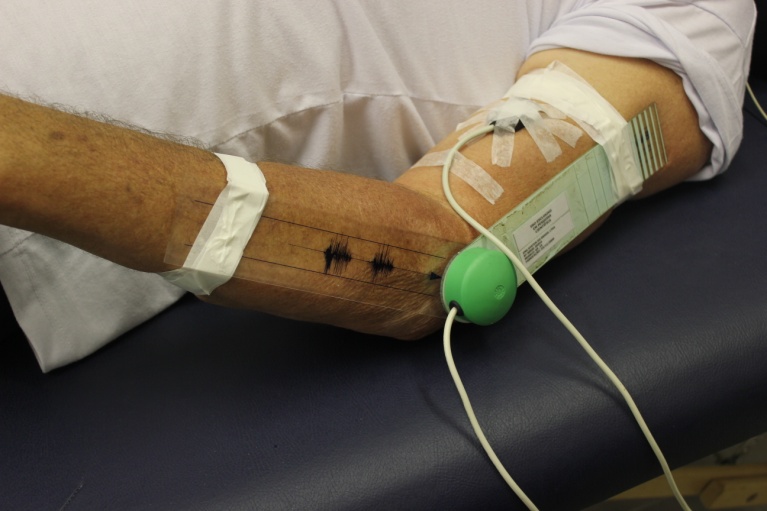 Stroke is one of the most incapacitating diseases affecting a significant number of people around the world. Most of the survivors suffer of neurological and motor deficits that impair their well-being and daily life. The rehabilitation of the motor capabilities of the upper-limbs is complex and, therefore, it is of interest to create new therapies that improve recovery. The goal of this research is to combine electromyographic (EMG) biofeedback and strengthening exercises as an alternative protocol for rehabilitation. We believe that such training will improve range of motion, alleviate spasticity and enhance the execution of daily-life activities.
Stroke is one of the most incapacitating diseases affecting a significant number of people around the world. Most of the survivors suffer of neurological and motor deficits that impair their well-being and daily life. The rehabilitation of the motor capabilities of the upper-limbs is complex and, therefore, it is of interest to create new therapies that improve recovery. The goal of this research is to combine electromyographic (EMG) biofeedback and strengthening exercises as an alternative protocol for rehabilitation. We believe that such training will improve range of motion, alleviate spasticity and enhance the execution of daily-life activities.
Candidate: Isabela Alves Marques
Advisor: Eduardo LM Naves
Novel Brain-Machine Interfaces based on connectivity analysis in EEG/ECoG signals
 This project proposes a new, alternative method for designing Brain-Machine Interfaces (BMIs). The method relies on mapping connectivity patterns in EEG/ECoG signals. Connectivity can be measured by extracting correlations between signals captured from different electrodes. Commonly employed methods are: phase synchronization analysis and dynamic bayesian networks for functional and effective connectivity, respectively. From this mapping, an algorithm for extracting motor intentions will be developed for BMI applications.
This project proposes a new, alternative method for designing Brain-Machine Interfaces (BMIs). The method relies on mapping connectivity patterns in EEG/ECoG signals. Connectivity can be measured by extracting correlations between signals captured from different electrodes. Commonly employed methods are: phase synchronization analysis and dynamic bayesian networks for functional and effective connectivity, respectively. From this mapping, an algorithm for extracting motor intentions will be developed for BMI applications.
Candidate: Mariana Cardoso Melo
Advisor: Alcimar B Soares
Comparison among contrast enhancement techniques in different mammographic imaging (FFDM vs.Tomoshynthesis).
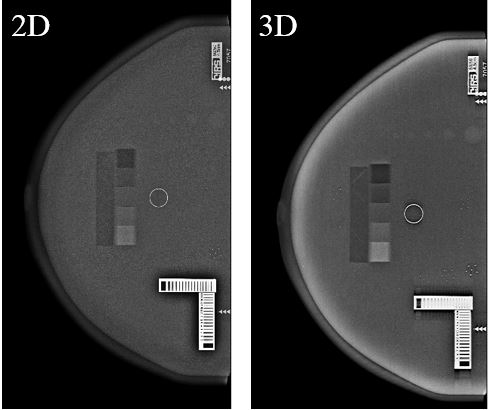
Candidate: Pedro Cunha Carneiro
Advisor: Ana C Patrocinio


